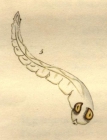
| About | | Search taxa | | Taxon tree | | Search literature | | Specimens | | Distribution | | Checklist | | Stats | | Log in |
Polychaeta name detailsDiplotis hyalina Montagu, 1816
338455 (urn:lsid:marinespecies.org:taxname:338455)
uncertain > taxon inquirendum (indeterminable insect larva)
Species
marine,
recent only
Montagu G. (1816). An account of some new and rare marine British shells and animals. <em>Transactions of the Linnean Society of London.</em> 11(2): 179-204, pls 12-14 ["1815"; 24 January 1816]., available online at http://biodiversitylibrary.org/page/756731
page(s): 203, figure is not 6-7, but instead figure 5; note: Devon coast, rare [details]
Note Devon coast, likely the coast near Kingsbridge...
From editor or global species database
Type locality Devon coast, likely the coast near Kingsbridge Estuary, England. Montagu does not give a more precise location than Devon coast. [details]
Taxonomy Diplotis hyalina is not an annelid. A complex figure numbering difference between the Montagu plate and the figure captions...
Taxonomy Diplotis hyalina is not an annelid. A complex figure numbering difference between the Montagu plate and the figure captions (corrected in an erratum slip) meant that Diplotis hyalina was by some authors wrongly thought to be figures 6 and 7 in the plate (actually Spio crenaticornis), rather than the actual figure 5. This assumption has perpetuated through the 20thC. Hartman catalogue (1959) placed Diplotis Montagu as a synonym of Polydora, but has no reference to the species Diplotis hyalina. Spionid taxonomists such as Foster (1971:18) and Light(1978:164) included Diplotis Montagu in the synonymy of Polydora, perhaps following the mention in McIntosh, but his inclusion in a synonymy was not in relation to Montagu's Diplotis but to Garner's subsequent usage for a spionid (McIntosh's Diplotus [sic] for Diplotis usage of Garner, 1838 [1841] referred to Polydora ciliata) [details]
Read, G.; Fauchald, K. (Ed.) (2021). World Polychaeta database. Diplotis hyalina Montagu, 1816. Accessed at: http://www.marinespecies.org/polychaeta/aphia.php?p=taxdetails&id=338455 on 2024-04-23
Date action by
original description
Montagu G. (1816). An account of some new and rare marine British shells and animals. <em>Transactions of the Linnean Society of London.</em> 11(2): 179-204, pls 12-14 ["1815"; 24 January 1816]., available online at http://biodiversitylibrary.org/page/756731
page(s): 203, figure is not 6-7, but instead figure 5; note: Devon coast, rare [details] additional source McIntosh, William Carmichel. (1915). Polychaeta, Opheliidae to Ammocharidae. <em>A Monograph of the British Marine Annelids.</em> The Ray Society, London, 3 (1): i-viii, 1-368 (text)., available online at https://biodiversitylibrary.org/page/38532650 page(s): 198; note: Diplotus [sic] for Diplotis usage of Garner, 1838 [1841] referred to Polydora ciliata [details] From editor or global species database
Taxonomy Diplotis hyalina is not an annelid. A complex figure numbering difference between the Montagu plate and the figure captions (corrected in an erratum slip) meant that Diplotis hyalina was by some authors wrongly thought to be figures 6 and 7 in the plate (actually Spio crenaticornis), rather than the actual figure 5. This assumption has perpetuated through the 20thC. Hartman catalogue (1959) placed Diplotis Montagu as a synonym of Polydora, but has no reference to the species Diplotis hyalina. Spionid taxonomists such as Foster (1971:18) and Light(1978:164) included Diplotis Montagu in the synonymy of Polydora, perhaps following the mention in McIntosh, but his inclusion in a synonymy was not in relation to Montagu's Diplotis but to Garner's subsequent usage for a spionid (McIntosh's Diplotus [sic] for Diplotis usage of Garner, 1838 [1841] referred to Polydora ciliata) [details]Type locality Devon coast, likely the coast near Kingsbridge Estuary, England. Montagu does not give a more precise location than Devon coast. [details] |
